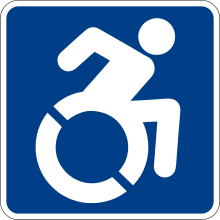Adoption of new disability signage spreads
Advocacy groups and lawmakers around the country have undertaken efforts at the state and city level to revamp the traditional “handicapped” or accessibility signage. In a statement from the Governor’s office celebrating the change, New York assemblywoman Sandy Galef, who was involved in efforts to update signage in New York state, explained: “The disability community is hindered by outdated language and symbols that stigmatize them and align them with a negative connotation or an image of immobility.”

With a petition on the books at Change.org, adoption of Hendren and Glenney’s redesigned International Symbol of Access is catching on in the U.S.
The advocacy paid off; last year state lawmakers adopted a change to the disabled/handicapped signage, making New York the first state to make such a shift at the statewide level. The new sign does away with the word “handicapped” and also features a more dynamic picture.
While the new picture is reminiscent of the old version in that it retains the blue background and white outline of a person in a wheelchair, the new version evokes motion. That seemingly simple shift means a lot to a lot of people. “I think a sign can change people. A sign stands for something. It means something to people,” said Frank Camarata, who runs the Erie County Office for the Disabled. The change was approved in July, 2014.
Now other states and municipalities are following suit. This year in Minnesota, high school student Hope Hoffman, who has spina bifida, is leading a charge to remove the words “handicapped,” “disability,” and “disabled” from parking, bathroom, and entrance signs. Her message: those words, she says, are “marginalizing” and evokes images of someone who is “broken down, incapable, and powerless.”
Hoffman thinks we should refer to “people first,” and also points out that not everyone who uses designated accessibility spaces has a disability. “Women who are pregnant, the elderly, [and] a lot of people recovering from injuries” also use them. Hoffman’s father is a state senator and her aunt is a state representative, and they are, respectively, sponsoring the bill in Minnesota on Hoffman’s behalf.
A similar push is underway in Connecticut, where advocates are pushing for a statewide change to current signage. The campaign is called “Change the Sign. Change the Attitude” and has elicited widespread support from an online signature drive via Change.org. The proposed sign uses the word “reserved” instead of “handicapped” or a version of “accessible.” Like the New York signage, the proposed sign in Connecticut also features an image of a person moving in a wheelchair. Campaign language explains: “This issue is not about changing a sign. It is about changing expectations. It’s not about changing the community for a few of us. It is about improving the community for all of us.”
While the campaign in Connecticut is limited to that state, many people who signed the Change.org petition are from other states. A signer from Florida commented: “The term handicapped paints a picture of someone less whole,” while another signer from Massachusetts wrote, “This is a small and easy change that can make big waves when it comes to attitudes and perceived notions.”
Indeed, this movement is not limited to the states that have already adopted or are undergoing legislation, and it didn’t simply crop up last year with the bill in New York. The Accessible Icon Project started in 2010 as “a guerilla street art campaign” that involved spraypainting a redesigned icon on top of existing parking signs and stencils. (The sticker features a symbol that is strikingly similar to the one adopted in New York and proposed in the municipality of New Haven.)
The project is based on founders Sara Hendren and Brian Glenney admit is graffiti, but it has evolved to receive broad-based attention and acceptance. According to the project’s website, “Since [the project’s] inception, educational institutions, private companies, cities and townships, governmental organizations, hospitals, and — most importantly — individual activists all over the world have appropriated the new icon for their own purposes.”
The Museum of Modern Art in New York accessioned the project for its permanent collection in Architecture and Design in 2013. Today, anyone can download the icon for free. The Accessible Icon Project website highlights stories from around the world about people adopting and using the new signage. Stories come from everywhere from Cleveland to Japan, suggesting a truly international movement.










